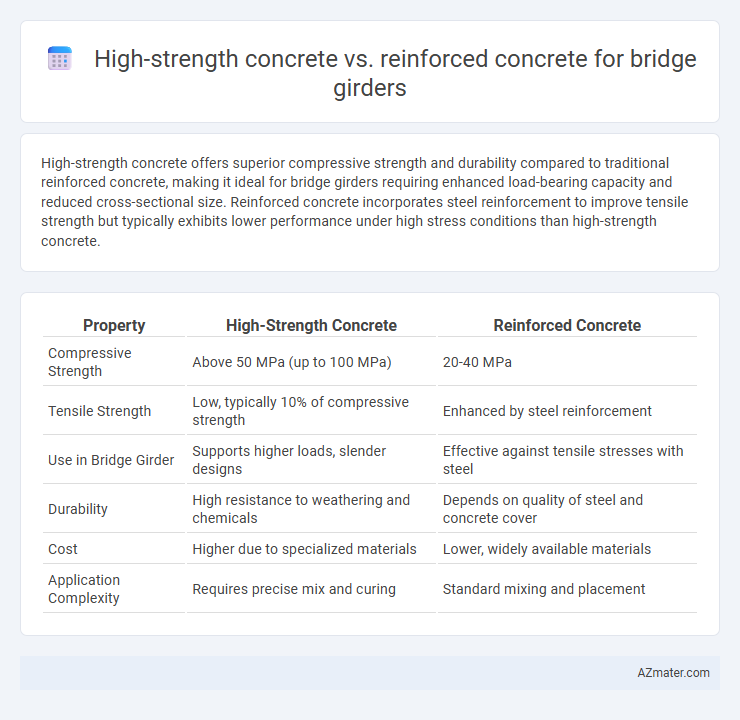High-strength concrete offers superior compressive strength and durability compared to traditional reinforced concrete, making it ideal for bridge girders requiring enhanced load-bearing capacity and reduced cross-sectional size. Reinforced concrete incorporates steel reinforcement to improve tensile strength but typically exhibits lower performance under high stress conditions than high-strength concrete.
Table of Comparison
| Property | High-Strength Concrete | Reinforced Concrete |
|---|---|---|
| Compressive Strength | Above 50 MPa (up to 100 MPa) | 20-40 MPa |
| Tensile Strength | Low, typically 10% of compressive strength | Enhanced by steel reinforcement |
| Use in Bridge Girder | Supports higher loads, slender designs | Effective against tensile stresses with steel |
| Durability | High resistance to weathering and chemicals | Depends on quality of steel and concrete cover |
| Cost | Higher due to specialized materials | Lower, widely available materials |
| Application Complexity | Requires precise mix and curing | Standard mixing and placement |
Introduction to Bridge Girders
Bridge girders serve as the primary horizontal supports transferring loads from the bridge deck to the piers and abutments. High-strength concrete offers enhanced compressive strength and durability, making it suitable for slender, lightweight girders that can withstand higher stress. Reinforced concrete integrates steel reinforcement to resist tensile stresses, providing flexibility and reliability for various bridge girder designs under complex loading conditions.
Defining High-Strength Concrete
High-strength concrete (HSC) is defined by its compressive strength typically exceeding 6,000 psi (41 MPa), offering enhanced durability and load-bearing capacity compared to conventional concrete. In bridge girders, HSC allows for slimmer, lighter structural elements without compromising strength, improving overall efficiency and lifespan. Reinforced concrete incorporates steel reinforcement bars to handle tensile stresses, whereas HSC relies on its superior material properties to reduce the amount or size of reinforcement needed.
Understanding Reinforced Concrete
Reinforced concrete for bridge girders combines concrete's compressive strength with steel reinforcement's tensile capacity, enhancing structural integrity under dynamic loads. It offers superior durability and crack resistance, crucial for long-span bridges subjected to variable stress and environmental conditions. High-strength concrete can be integrated within reinforced concrete to improve performance, but reinforcement remains essential for managing tensile forces and preventing brittle failure.
Structural Properties Comparison
High-strength concrete offers superior compressive strength typically exceeding 70 MPa, leading to lighter and more slender bridge girders with enhanced load-carrying capacity compared to conventional reinforced concrete. Reinforced concrete combines moderate concrete strength (usually 20-40 MPa) with steel reinforcement to resist tensile stresses, providing ductility and improved crack control under dynamic loads. While high-strength concrete reduces girder self-weight and increases stiffness, reinforced concrete ensures better energy dissipation and failure warning, making the choice dependent on specific structural performance and durability requirements.
Material Composition and Mix Design
High-strength concrete for bridge girders incorporates a lower water-cement ratio, high cement content, and admixtures such as silica fume or fly ash to achieve compressive strengths typically above 60 MPa, enhancing durability and load capacity. Reinforced concrete mix designs prioritize balanced proportions of cement, aggregates, water, and steel reinforcement to optimize tensile strength and crack resistance, with typical compressive strengths ranging from 20 to 40 MPa. Material composition in high-strength concrete focuses on dense microstructure and reduced porosity, whereas reinforced concrete emphasizes steel rebar integration within a standard concrete matrix for structural support.
Load-Bearing Capacity Analysis
High-strength concrete offers superior compressive strength, typically exceeding 6000 psi, enhancing the load-bearing capacity of bridge girders by reducing cross-sectional dimensions and improving durability under heavy traffic loads. Reinforced concrete, incorporating steel reinforcement bars, provides enhanced tensile strength crucial for resisting bending moments and shear forces, ensuring structural integrity in dynamic loading conditions. Load-bearing capacity analysis shows that combining high-strength concrete with optimized reinforcement layout significantly increases bridge girder performance by maximizing stiffness and minimizing deflection under service loads.
Durability and Longevity Factors
High-strength concrete offers superior compressive strength and improved durability against environmental factors such as chloride penetration and freeze-thaw cycles, making it highly suitable for bridge girders exposed to harsh conditions. Reinforced concrete, incorporating steel reinforcement, enhances tensile strength and ductility but requires adequate cover and corrosion protection to ensure long-term performance. Optimizing concrete mix design and protective measures significantly influences the longevity and structural integrity of bridge girders in both high-strength and reinforced concrete applications.
Construction Techniques and Challenges
High-strength concrete for bridge girders demands precise mix design and advanced curing methods to achieve enhanced compressive strength above 6,000 psi, offering increased load capacity and reduced cross-sectional dimensions compared to conventional reinforced concrete. Construction techniques for high-strength concrete require careful control of temperature, moisture, and placement to prevent early-age cracking and ensure proper bonding with reinforcement, while specialized self-consolidating mixes improve flowability in complex formworks. Reinforced concrete girders, although more forgiving in placement, face challenges like congestion of steel bars and potential corrosion, requiring meticulous detailing and protective measures to ensure durability and structural integrity.
Cost Efficiency and Lifecycle Analysis
High-strength concrete (HSC) offers superior compressive strength and durability compared to conventional reinforced concrete (RC), enabling slimmer bridge girder designs that reduce material usage and overall weight, leading to initial cost savings. Lifecycle analysis shows HSC girders demand less maintenance due to enhanced resistance to cracking and environmental degradation, thereby lowering repair costs and extending service life. Despite HSC's higher upfront material cost, its cost efficiency over the lifecycle is superior when factoring in reduced maintenance frequency and improved structural performance under high loads.
Application Suitability for Bridges
High-strength concrete (HSC) offers superior compressive strength and durability, making it ideal for bridge girders subject to heavy loads and long spans, enhancing structural efficiency and reducing girder size. Reinforced concrete combines concrete's compressive strength with steel reinforcement's tensile capacity, providing versatility for various bridge designs and effective resistance to bending and shear forces. HSC is more suitable for high-performance, long-span bridges requiring reduced self-weight, while reinforced concrete remains preferred for conventional bridge girders due to cost-effectiveness and established construction techniques.

Infographic: High-strength concrete vs Reinforced concrete for Bridge girder
 azmater.com
azmater.com